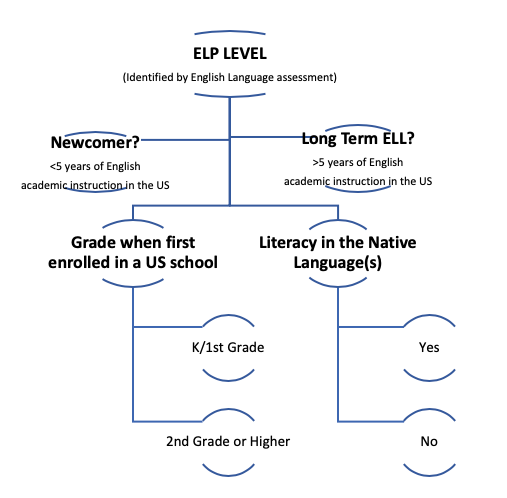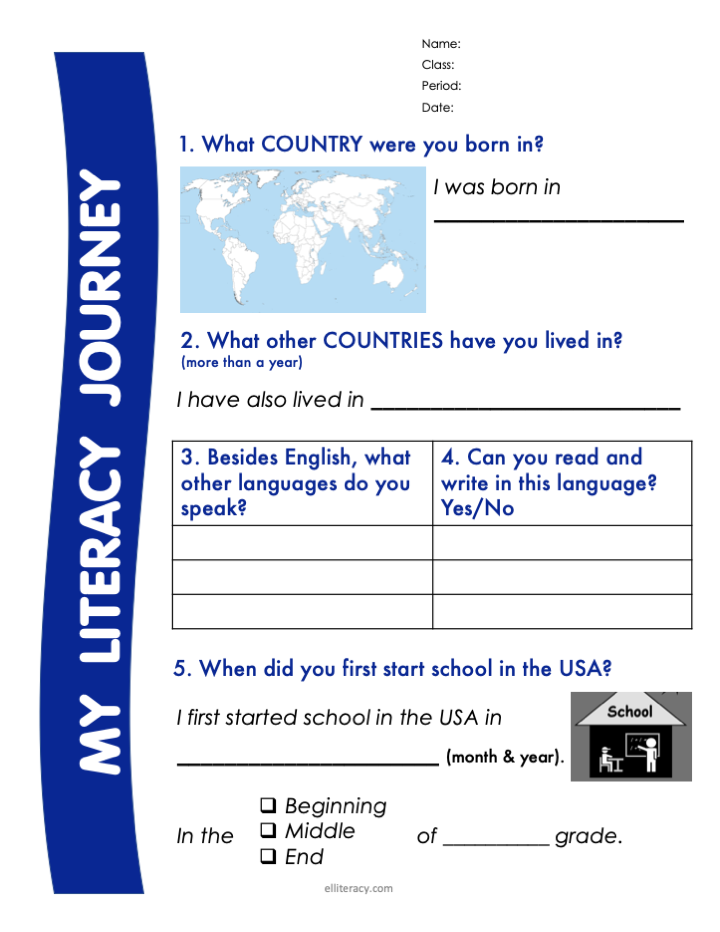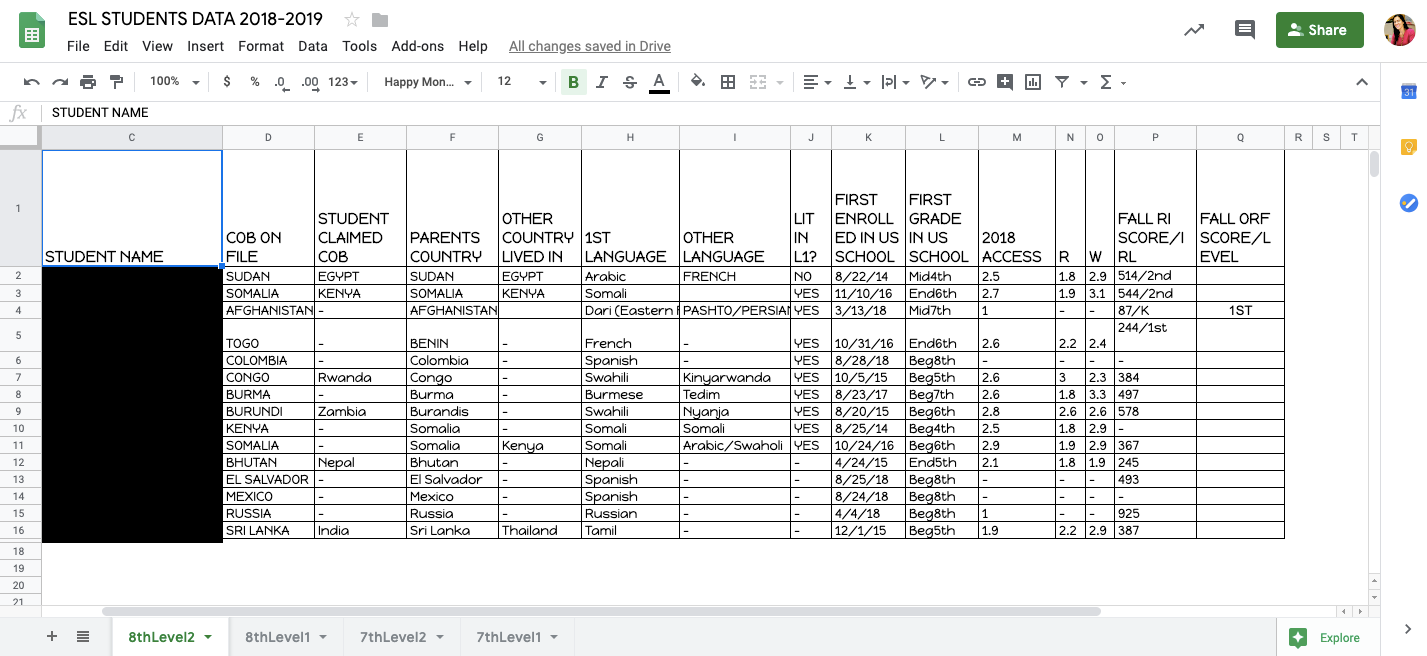Having a clear notion what these levels represent as to what students are able to do with the English language, is a great starting point. However, considering these test scores alone, will limit our perception of ELLs' abilities and needs, and consequently, the appropriateness of the services and instructional accommodations offered to them. There are several other factors that largely affect the progression of second language learning, which is quite evident when teaching ELLs within the same proficiency Level. As an ESL (English as a Second Language) teacher of over 16 years, I have come to realize that there are at least three crucial variables that cannot be overlooked, when making instructional decisions for my students.
1. Newcomer or Long Term ELL?
One of the first factors to consider, after identifying the student's English Proficiency Level, is the number of school years the student has been receiving academic English instruction in the USA. This will help us determine their language and academic needs better. The terms Newcomer and Long Term ELL only diverge based on the number of years the student has been receiving English instruction in the US. Although research in second language acquisition suggests that it can take up to seven years for a learner to become fluent in a second language, determining how many years it takes for a student to shift from being a Newcomer to becoming a Long Term ELL, might be debatable. Based on the Non-Regulatory Guidance for English Learners and Title III of the Elementary and Secondary Education Act (ESEA), as amended by the Every Student Succeeds Act (ESSA) of 2016, schools receiving Title III subgrants are required to report the number and percentage of ELLs who have not yet attained English language proficiency within five years of initial classification and first enrollment in a US school, labeling them as Long Term ELLs. Based on this definition and by inherent contrast, a Newcomer is a student who has recently (less than five years) moved to the USA from a country where English is not the main language of academic instruction.
Now, how do these two definitions affect instructional planning and provision of services? Picture the scenario of two different Ninth grade, Level 2 ELL students: One is a newcomer, with two years of English academic instruction in a US school, and the other one is a Long Term ELL with five consecutive years of English academic instruction in the US. Would these two students have similar academic needs and strengths? Would the same pattern of services be appropriate for both of them? Most likely not; and it is very important that as teachers, we consider this information before making significant instructional decisions for our students, along with a couple more variables.
2. Grade when first enrolled in a US school
This information is crucial in determining student's appropriate progression of English Language development. Think about the curricular content and literacy instruction taking place in the lower grades versus the higher grades in school. A student who starts their schooling experience in the US in Kindergarten or First Grade, will have significant advantages over a student who is first enrolled in a US school in upper grade levels. In the lower grades, students learn foundational literacy skills that will support the development of English as a new language. They learn essential reading and writing skills such as phonemic awareness, phonics, text-to-sound correspondence, sight words and spelling patterns. Additionally, students in lower grades have more opportunities to read along and read aloud with leveled passages, while receiving immediate input from their teachers. They have a lot more opportunities for oral reading fluency practice and many other skills fundamental for literacy development, which is well known to accelerate the process of learning a second language.
Knowing whether an ELL student has received instruction in these fundamental literacy skills, offers a great insight as to what specific areas of language development students need support in. Nevertheless, even with this information thus far, there is one more factor we need to consider to appropriately guide our instruction and ensure adequate services for our ELLs.
3. Literacy in the Native Language(s)
When referring to literacy here, we are alluding to the basic components of reading and writing, the ability to use written language actively and passively. Having knowledge of your ELL students' literacy levels in their first language(s), can help you understand possible challenges they may encounter when learning English as a new language. Literacy levels are usually parallel to students' schooling backgrounds. It is almost safe to assume, that if an ELL has had consistent formal education in their native country, they will also be literate in the language of instruction. By contrast, if an ELL has had interrupted schooling or no education at all, most likely they will not be literate in their first language.
This variable is one of the most consequential in English Language development. Although you may have ELL students classified into the same proficiency Level, differences in their schooling and literacy experience, will affect the pace and progression of their English development. Similarly, the structure of the student's native language or language of literacy, will have an effect on their English learning. It is important to consider the differences in students' native languages, as it can help us identify potential points of struggle when learning to read and write in English.

*Variables to consider when making instructional decisions about ELLs
All three of these factors have a significant effect on students' English Language development. However, with this wide breadth of language, academic, and literacy levels between ELLs, how can a teacher compile and make sense of all of this data to apply it in their instruction? One suggestion to facilitate the gathering of information on your students' backgrounds, is to create a form that you can use in a lesson, where you can guide your students in filling out as much information as possible. Below you will see an example of a worksheet titled "My Literacy Journey", which I created to help me gather this data. You can download it for free, from my TpT store elLiteracy.


I use this form in my classes at the beginning of every school year and as new students come in. Once I collect this data, I populate a spreadsheet that I refer to constantly, to ensure appropriate instructional decisions for my students (see example below).
Although it may seem overwhelming at first, not having this understanding of your students' academic, language, and literacy backgrounds will make your instructional goals a lot harder to achieve. Caring enough to make this extra effort to know your students, will not only impact their learning, but also make your instructional planning easier. Only when an educator can state with certainty that they do know their students, one can contemplate that effective teaching and appropriate levels of learning are taking place in the classroom. Identifying these significant differences between ELLs within the same Language Proficiency Level, will undoubtedly help us be true forces of equity in the classroom.
References
Grantmakers for Education. 2013. Educating English Language Learners: Grantmaking Strategies for Closing America's Other Achievement Gap.
https://edfunders.org/sites/default/files/Educating%20English%20Language%20Learners_April%202013.pdf
Non-Regulatory Guidance: English Learners and Title III of the Elementary and Secondary Education Act (ESEA), as amended by the Every Student Succeeds Act (ESSA), p. 38, 2016,
https://www2.ed.gov/policy/elsec/leg/essa/essatitleiiiguidenglishlearners92016.pdf